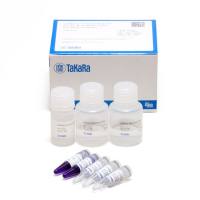Glycosylphosphatidylinositols (GPIs) are a family of structures that contain the structural motif: Manα1-4GlcNH
2 α1-6
myo -Inositol-1-PO
4 -lipid. This common substructure suggests that this family of molecules are biosynthetically related and differentiates them from other glycosylated phosphoinositides, such as the glycosylated phosphatidylinositols of mycobacteria and the glycosylated inositol phosphoceramides of yeasts and plants. The GPI family can be conveniently divided into two groups based on structural homology and function. The first group (
1 –
28 ) are the membrane protein anchors (Fig. 1 ) that are found covalently linked to the C-termini of a wide variety of externally disposed plasma membrane proteins throughout the eukaryotes These GPI anchors afford a stable attachment of proteins to the membrane and can be viewed as an alternative mechanism of membrane attachment to a single-pass hydrophobic transmembrane peptide domain. For recent reviews of GPI anchor structure, biosynthesis, and function
see refs. 29 –
31 . The second group of GPI structures have only been found in protozoan organisms. These molecules exist as free glycophospholipids, such as the glycoinositol phospholipids (GIPLs) of the
Leishmania, Trypanosoma cruzi, Leptomonas, Herpetomonas , and
Phytomonas (
29 ,
32 –
34 ), or attached to phosphorylated repeating units as in the lipophosphoglycans (LPGs) of the Leishmania (
29 ,
35 ). In this chapter protocols specifically designed to analyse the protein-linked GPI anchors, although they are also applicable to the GIPLs and, to some extent, the LPGs will be described.
Fig. 1. GPI anchor structures All GPI anchors attached to protein contain the conserved structure shown above with various substituents (R 1 –R 5 ) and lipids, as indicated. Some structures contain an additional fatty acyl chain attached to the 2-position of the myoinositol ring. All metazoan organisms contain at least one, and sometimes two, extra ethanolamine phosphate (EtNPO 4 ) substituents in addition to the one used as a bridge to the protein C-terminal amino acid. When a substituent is known to be attached to a certain sugar residue but the linkage position is unknown, this is indicated by a question mark. Square brackets are used to show substituents for which the site of attachment has not been determined. The � symbol indicates that the associated residue is found on only a proportion of the structures AEP is 2-amino-ethyl-phosphonate.


![四[N-邻苯二甲酰-(S)-叔亮氨酸基]二铑双(乙酸乙酯)加合物;154090-43-4;Elemental analysis(Nitrogen) 3.30 to 4.50 %;V66234-25mg](https://img1.dxycdn.com/p/s14/2025/1029/004/8672158669127143891.jpg!wh200)



